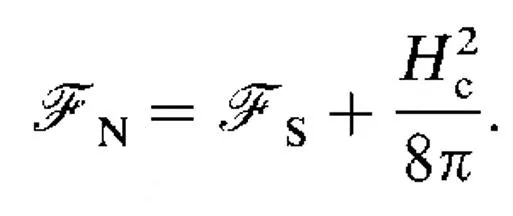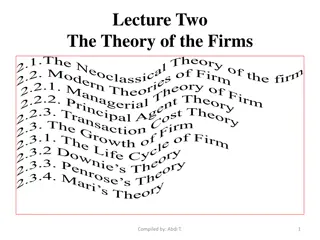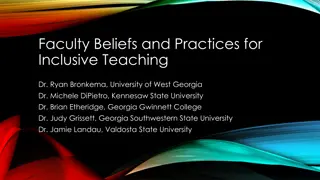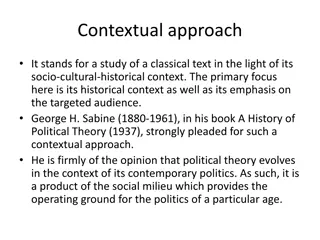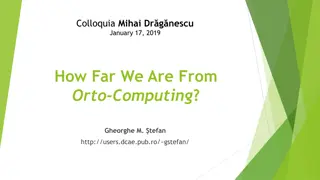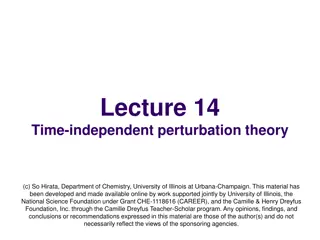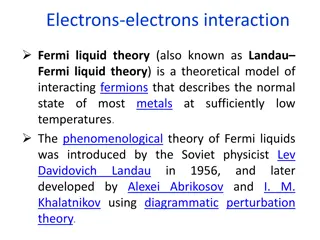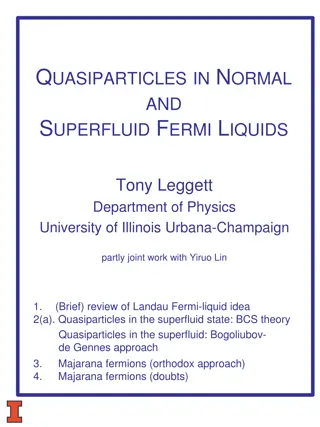Ginzburg Landau phenomenological Theory
The Ginzburg-Landau phenomenological theory explains superconductivity and superfluidity as distinct thermodynamic phases. It focuses on phase transitions characterized by singularities in specific heat at the transition temperature. Derived from BCS theory, it quantifies condensation energy, emphasizing the small energy scale relative to Fermi energy. Landau's general approach to second-order phase transitions underlies this theory, emphasizing order parameters that distinguish between states.
Download Presentation

Please find below an Image/Link to download the presentation.
The content on the website is provided AS IS for your information and personal use only. It may not be sold, licensed, or shared on other websites without obtaining consent from the author.If you encounter any issues during the download, it is possible that the publisher has removed the file from their server.
You are allowed to download the files provided on this website for personal or commercial use, subject to the condition that they are used lawfully. All files are the property of their respective owners.
The content on the website is provided AS IS for your information and personal use only. It may not be sold, licensed, or shared on other websites without obtaining consent from the author.
E N D
Presentation Transcript
Ginzburg Landau phenomenological Theory The superconducting state and the normal metallic state are separate thermodynamic phases of matter in just the same way as gas, liquid and solid are different phases. Similarly, the normal Bose gas and BEC, or normal liquid He4and super-fluid He II are separated by a thermodynamic phase transitions. Each such phase transition can be characterized by the nature of the singularities in specific heat and other thermodynamic variables at the transition Tc. The problems of superfluidity and superconductivity were examined from the point of view of the thermodynamics of phase transitions.
Ginzburg Landau phenomenological Theory The theory of superconductivity introduced by Ginzburg and Landau in 1950 describes the superconducting phase thermodynamic point of view. It was originally phenomenological theory, but later Gor kov showed that it can be derived from full the mi- croscopic BCS theory in a suitable limit. Condensation Energy transition from this introduced as a
Ginzburg Landau phenomenological Theory The quantity 0H2c/2 is the condensation energy in SI unit. It is a measure of the gain in free energy per unit volume in the superconducting state compared to the normal state at the same temperature. As an example lets consider niobium. Here Tc= 9K, and Hc= 160kA/m (Bc= 0Hc = 0.2T). The condensation energy 0H2c/2 = 16.5kJ/m3. Given that Nb has a bcc crystal structure with a 0.33nm lattice constant we can work out the volume per atom and find that the condensation energy is only around 2 eV/atom! Such tiny energies were a mystery until the BCS theory, which shows that the condensation energy is of order (kBTc)2g(EF), where g(EF) is the density of states at the Fermi level. The energy is so small because kBTcis many orders of magnitude smaller than the Fermi energy, F.
Ginzburg Landau phenomenological Theory The Ginzburg-Landau theory of superconductivity is built upon a general approach to the theory of second order phase transitions which Landau had developed in the 1930 s. Landau had noticed that typically second order phase transitions, such as the Curie temperature in a ferromagnet, involve some change in symmetry of the system. For example a magnet above the Curie temperature, TC, has no magnetic moment. But below TCa spontaneous magnetic moment develops. In principle could point in any one of a number of different directions, each with an equal energy, but the system spontaneously chooses one particular direction. In Landau s theory such phase transitions are characterized by an order parameter which is zero in the disordered state above Tc, but becomes non-zero below TC. In the case of a magnet the magnetization, M(r), is a suitable order parameter.
Ginzburg Landau phenomenological Theory For superconductivity Ginzburg and Landau (GL) postulated the existence of an order parameter denoted by . This characterizes the supercon- ducting state, in the magnetization does in a ferromagnet. The order parameter is assumed to be some (unspecified) physical characterizes the state of the system. In the normal metallic state above the critical temperature Tc of the superconductor it is zero. While in the superconducting state below Tc it is non-zero. same way as the quantity which
Ginzburg Landau phenomenological Theory Therefore it is assumed to obey: Ginzburg and Landau postulated that the order parameter should be a complex number, thinking of it as a macroscopic wave function for the superconductor in analogy with superfluid4He. At the time of their original work the physical significance of this complex in superconductors was not at all clear. But, in the microscopic BCS theory of superconductivity there appears a parameter, , which is also complex. Gor kov was able to derive the Ginzburg-Landau theory from BCS theory, and show that is essentially the same as , except for some constant. numerical factors. In fact, we can even identify | |2as the density
Ginzburg Landau phenomenological Theory Ginzburg and Landau assumed that the free energy of the superconductor must depend smoothly on the parameter . Since is complex and the free energy must be real, the free energy can only depend on | |. Furthermore, since goes to zero at the critical temperature, TC, we can Tailor expand the free energy in powers of | |. For temperatures close to TConly the first two terms in the expansion should be necessary, and so the free energy density (F) must be of the form:
Ginzburg Landau phenomenological Theory Here fs(T) and fn(T) are the superconducting state and Clearly above Eq. is the only possible function which is real for any complex near differentiable function of and *near to = 0. The parameters a(T) and temperature dependent pheonomenological parameters of the theory. However it is assumed that they must be smooth functions of temperature. We must also assume that b(T) is positive, since otherwise the free energy density would have no minimum, which would be unphysical (or we would have to extend the expansion to include higher powers such as | |6). = 0 and which is a b(T) are, in general,
Ginzburg Landau phenomenological Theory Plotting Fs Fnas a function of is easy to see that there are two possible curves, depending on the sign of the parameter a(T), as shown in Fig. In the case a(T) > 0, the curve has one minimum at = 0. On the other hand, for a(T) < 0 there are minima wherever | |2= a(T)/2b(T). Landau and Ginzburg assumed that at high temperatures, above TC, we have a(T) positive, and hence the minimum free energy solution is one with = 0, i.e. the normal state. But if a(T) gradually decreases as the temperature T is reduced, then the state of the system will change suddenly when we reach the point a(T) = 0. Below this temperature the minimum free energy solution changes to one with 0. Therefore we can identify temperature ,where , a(T) becomes zero as the critical Temperature TC.
Ginzburg Landau phenomenological Theory Near to this critical temperature, Tc, assuming that the coefficients a(T) and b(T) change smoothly with temperature, we can make a Taylor expansion, a(T) a (T Tc) + . . . b(T) b + . . . ,
Ginzburg Landau phenomenological Theory (1) F is now the total free energy. Eq. (1) in its present form does not model the increase in energy associated with a spatial distortion of the order parameter, i.e., effects associated with a coherence length, . To account for such effects Ginzburg and Landau added a 'gradient energy' term to (1) 0f the form
Ginzburg Landau phenomenological Theory Hence Finally we must add the contribution of the magnetic field to the energy density
Ginzburg Landau phenomenological Theory Combining the above (2) (2)
variation with respect to , which is an independent Variable, yields the complex conjugate of (2). To minimize , we set the integrand of the of above to zero; this yields the first G-L equation.
Ginzburg Landau Equation Variation of Eq. (2) w.r.t A where
Provided we identify J(r) as Or equivalently This is the 2nd Ginzburg landau equation which is same as the current density in quantum Mechanics
Boundaries and boundary conditions We first examine a simple case involving an inhomogeneous order parameter generated by the presence of a boundary, in the absence of a magnetic field. Assume we have a superconducting half space occupying the region x > 0. We further assume that the order parameter is driven to zero at this interface. Experimentally this can be accomplished by coating the surface of the superconductor with a film of ferromagnetic material.
continue G L equation In one dimension becomes
continue a is negative in the superconducting state Substituting The above diff. equation becomes
continue Multiplying by the diff. Eqn. can be written as This means that the quantity in bracket is constant. = C
continue Far from the boundary the and hence f is constant. This employs that f =0 and Then the above diff. equation becomes Which has the solution
continue or Thus we see that the is the measure of distance over which it responds to perturbation. Since
continue we have We see that the G L coherence length diverges as this divergence is a general property of the coherence length at all second order phase transitions (although the exponent differs in general from this 'mean field' value of 1/2 close to TC).
continue we have We see that the G L coherence length diverges as this divergence is a general property of the coherence length at all second order phase transitions (although the exponent differs in general from this 'mean field' value of 1/2 close to TC).
London equation from GL equation 2nd GL equation In the limit when the two first term is negligible then the equation is nothing but London equation J(r) = Provided
London equation from GL equation Or, Thus we see that in G-L theory L and both diverges as The ratio, called G-L parameter is independent of temperature and constant.
Surface energy at phase boundary At phase boundary By definition Or,
London equation from GL equation Inserting for F in G And and using definition of G
Surface energy at phase boundary We obtain for , The vanishing of the cross term in both in above equation and the first G-L equation allows us to choose real; it then follows from 2nd G-L that
Surface energy at phase boundary continue And To compute g we must simultaneously solve the first and second G-L equations, for y(x) and B(x) = -(dA(x)/dx)), subject to boundary conditions and substitute in the equation for g.
Surface energy at phase boundary To simplify the calculation we rewrite in scaled var- iable The GL eqn becomes and
Surface energy at phase boundary The solution for arbitrary k must be obtained numerically. The appropriate boundary condition And To obtain the first integral of GL 1st , multiply by y
Surface energy at phase boundary Multiplying 2nd by A Combining the above two eqn. The value of constant was fixed by boundary condition
Surface energy at phase boundary Using and scaled variables Combining this eqn. with the earlier eqn
Surface energy at phase boundary In general the soln of Can be computed if A (x) and y (x) are given. For A=0



